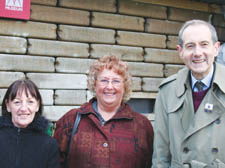| |

Outside the Cabinet War Rooms in Westminster: guides Diane Jones, Sheila Hind and David Evans |
A walk back in time reveals war secrets
Tour highlights Westminster’s WWII targets
IT'S a bitterly cold November morning
in St James’s.
Smartly turned out in a green trench coat and with a cut-glass accent and towering physique, David Evans would make a convincing military general, a kind of gregarious Field Marshal Montgomery. He is one of a new troop of guides, whose job it is to depose our collective school-day hang-up with the “Second World bore”.
By revisiting wartime Westminster and its blackouts and sirens, Mr Evans hopes to bring oxygen to those who mistakenly believe the East End was the only real casualty of the Blitz.
Bombs did fall on Westminster, most famously on the House of Commons and Westminster Abbey, leaving a death toll of 1,000 by 1945. Although there are no craters, much of Victoria Street is built on former smoked-out Victorian hulks and ghostly traces of “our darkest hour” still exist in the nooks and crannies of the historic district.
Among the lesser-known vignettes gleaned from the hour-and-half tour is an episode which it wouldn’t be an exaggeration to say might have changed the course of history.
MI6 headquarters in Broadway, nerve centre of British intelligence and promoter of such immortal phrases as “loose lips sink ships” and “careless talk costs lives,” was a house number away from going up in flames. A V-bomb landed on the neighbouring block (a site now occupied by the Ministry of Justice) during the last wave of Luftwaffe raids in May 1944.
“It was a whisker away from being hit. Because of the nature of the business we don’t know a lot about what went on in the building, but if MI6 was hit it’s not too much of a leap to see it would have had huge effect on the outcome of the war,” said Mr Evans.
Other unlikely wartime landmarks include the public baths in Great Smith Street (now home to the Abbey Centre), which with the advent of soap-rationing became a vibrant community hub, the telephone scrambling den in the basement of Selfridges and the air raid shelter at Caxton Hall, the first municipal facility of its kind when it was built in 1938.
“Caxton Hall is remarkable because it can lay claim to this feat as the first air-raid shelter. What’s more amazing it was built during the euphoria that followed Neville Chamberlain’s speech. Residents would cram into the shelter. Some would go to St James’s Underground, but it wasn’t really deep enough and the authorities didn’t like it because they thought nobody would come back up to the surface,” said Mr Evans.
The tour ends with a walk up Birdcage Walk to probably the most celebrated of all of wartime landmarks, the Cabinet War Rooms.
Westminster in the Second World War was the first of a series of walks organised by City of Westminster Guide Lecturers Association in conjunction with Westminster City Council. For more themed tours see local library listings. |
 |
|
| |
| |